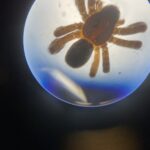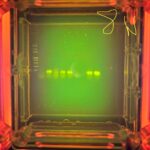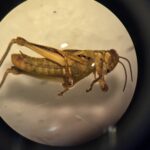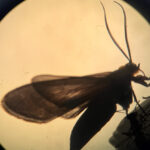Sample information |
|
| Picture |

|
|---|---|
| Location | |
| Collection date | 11/12/2024 |
| Captive / Cultivated? | Wild-caught |
| Group | Walton High School |
| Observations | Exhibits a brownish-black appearance, has ten appendages including jaws, is very hairy, has a black, roundish abdomen with white dots and a heart shaped thorax. Also appears to have black dots on appendages.
|
| Putative identification | Arthropoda Arachnida Araneae Salticidae |
Methods |
|
| Extraction kit | DNeasy (Qiagen) |
| DNA extraction location | Whole arthropod |
| Single or Duplex PCR | Single Reaction |
| Gel electrophoresis system | MiniPCR |
| Buffer | TBE |
| DNA stain | GelGreen |
| Gel images |

|
| Protocol notes | Lane 1 includes the DNA marker of double-stranded DNA fragment sizes 10k, 6k, 3k, 2k, 1k, 800, 600, 400, and 200 bp. The Gel shown is of the Wolbachia protocol, testing for the 16s rRNA gene only using specific primers. Lane 6 is of my jumping spider arthropod sample, with the negative arthropod control in lane 9 and the negative DNA control in lane 10. The positive arthropod control and the positive DNA control were not run in the Wolbachia protocol gel due to errors during preparation. The Arthropod protocol gel is not shown due to unclear results. |
Results |
|
| Wolbachia presence | Unknown |
| Confidence level | Low |
| Explanation of confidence level | The jumping spider arthropod sample for identifying Wolbachia 16s rRNA gene had a band that lined up with the DNA marker for 200 bp, where the negative DNA control and negative arthropod control had a band at. This could mean that preparation of the negative DNA control and/or negative arthropod control was done incorrectly, or the jumping spider arthropod sample had Wolbachia DNA but could not be determined due to the incorrectly prepared controls. |
| Wolbachia 16S sequence | |
| Arthropod COI sequence | Download AB1
GGGGGCTCTCTTGGTTAGCTGGTTTCCTCGTNGCTAGGC
BLAST at The Wolbachia Project BLAST at NCBI
|
| Summary | |
 Differential Grasshopper – Melanoplus differentialis
Differential Grasshopper – Melanoplus differentialis Pill Bug (Armadillidium vulgare) – Draft
Pill Bug (Armadillidium vulgare) – Draft Melanoplus Femurrubrum
Melanoplus Femurrubrum Grasshopper – Orthoptera
Grasshopper – Orthoptera Cisseps Fulvicollis
Cisseps Fulvicollis